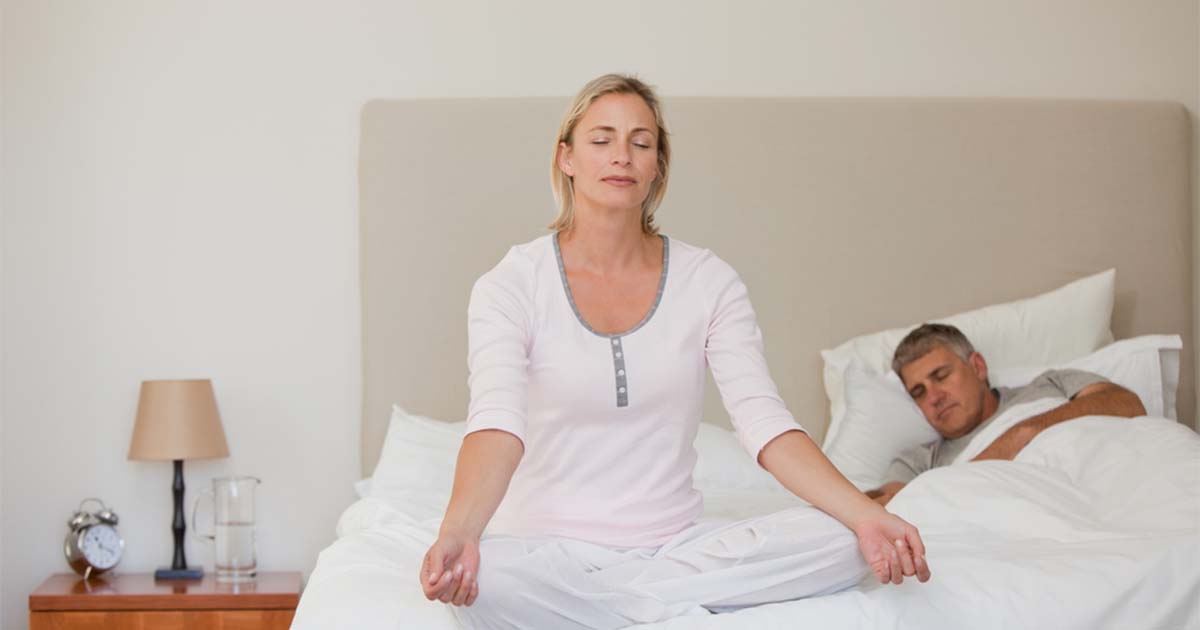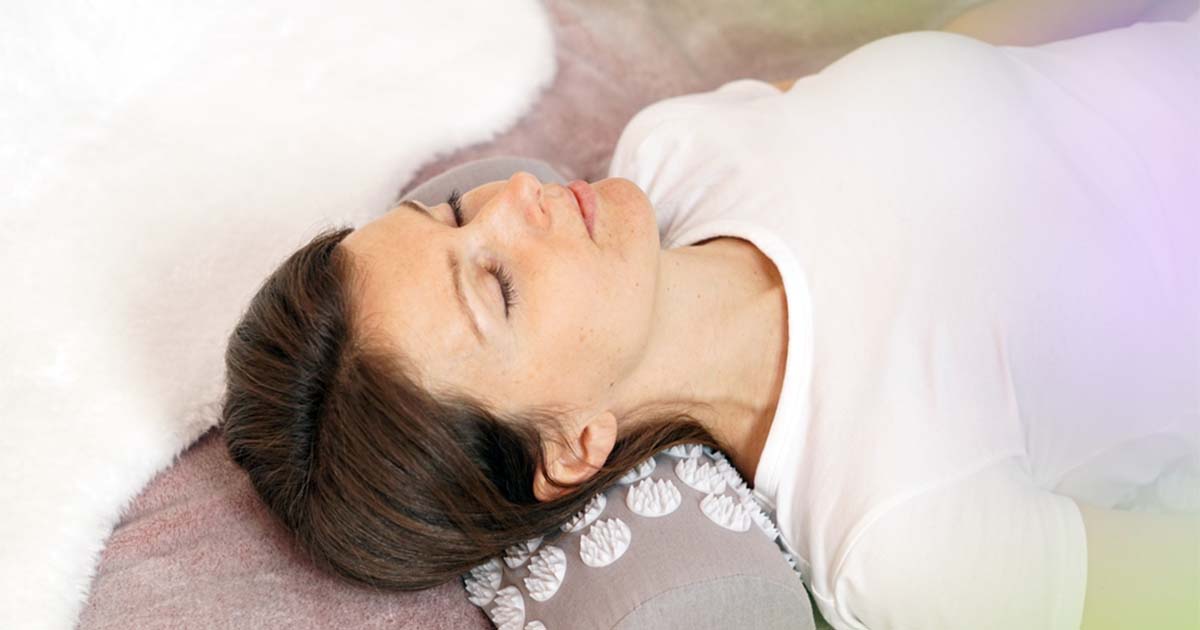Ever feel like your brain is constantly in overdrive? That’s likely because it is. We cram more and more into our days and live in a world of constant distraction — it’s no wonder that when bedtime rolls around, we struggle to relax and unwind.
We know that a consistent bedtime routine is a key to getting enough sleep, and meditation is one bedtime habit that can help you unwind from a busy day.
The practice of mediation dates back centuries, with origins in religion and spirituality. In recent years, the popularity of meditation has boomed in secular society. Celebrities (Paul McCartney, Katy Perry and Oprah Winfrey) and successful CEOs (Jeff Weiner, Marc Benioff and Arianna Huffington) all include meditation in their daily routines.
So what is bedtime meditation, and how can it help to improve your sleep?
Meditation is the process of creating space for your mind and body to find calm by observing your emotions, reactions, and thoughts in a structured way. It is designed to promote self-acceptance and peace of mind.
There are many benefits to meditation, including better concentration, enhanced creativity, and yes, better sleep.
Can meditation help you sleep?
Meditation can improve your sleep by activating your parasympathetic nervous system and signalling your body to rest and recover from activity. Meditating before sleep can help you to fall asleep faster, stay asleep longer and achieve a better quality of rest throughout the night. At a biological level, meditation can help regulate cortisol, a hormone involved in both stress responses and your circadian rhythm (sleep-wake cycle).
Emerging scientific evidence from Rush University Medical Centre in Chicago supports the use of mindfulness meditation to improve insomnia and sleep quality. Over eight weeks, participants noticed improved sleep, with benefits that continued for six months after the study completion.
Mindfulness meditation can even benefit healthy adults with no prior sleep problems. A 2020 randomised controlled trial at the University of Wisconsin found that mindfulness meditation reduced any adverse impacts of poor sleep on daily life, with benefits extending seven months after completion of the study.
What type of meditation should I do in bed?

A bedtime meditation should help you to release any concerns from the day and any feelings of anxiety that may inhibit your ability to relax into a restful sleep.
Before beginning any meditation, it can help to remove distractions (yes, that means putting your phone in another room) and ensure you will be undisturbed for 5-20 minutes.
Below we share some proven bedtime meditation techniques that you can try for yourself.
1. Breath meditation
This is a simple meditation that you can gradually increase. Start with as little as one minute and build up to five minutes or longer.
- Find a comfortable position, sitting or lying in bed.
- Relax your body from your head to your feet, becoming aware of where it touches the air, your clothing, the bedding, and pillows.
- Notice your breath and become aware of its flow in and out of your nose and throat. Observe whether it is shallow or whether your abdomen rises and falls.
- If your breathing is shallow and rapid, you might choose to slow down your breathing and draw air into your diaphragm or abdomen.
- When your mind wanders to thoughts, gently bring your awareness back to your breathing.
- Try to focus for one minute, increasing the time as the meditation becomes more comfortable.

2. Body scan meditation
A body scan is a popular meditation for relaxation. If you’ve ever been to a yoga class, you may have experienced a guided body scan meditation.
Here’s how to do it in the comfort of your bed:
- Sit or lay in a comfortable position.
- Become aware of your breath. Focus on one part of your body at a time.
- You might start with your toes, the arch of your feet, gradually working up to the top of your head. If you notice discomfort anywhere in your body, you might imagine warm light spreading through those areas before moving on to other areas of your body in sequence.
- Become aware of where your body holds tension and consciously release this tension. An effective way to do this is to tense and release each muscle.
- Once you have finished, take a few moments to rest and observe how your body feels.
3. The 5-4-3-2-1 grounding meditation
This meditation helps you become aware of your surroundings, finding peace in the present moment so you can more easily fall asleep. This meditation is helpful if you experience any anxiety at bedtime.
- Find a comfortable position in your bed where you can completely relax.
- Take a few conscious breaths as you become aware of your breathing.
- Note how you feel. Is your mind racing? Does your body feel tense?
- Begin the meditation with your eyes open. Identify five things that you can see. Become aware of how the light interacts with the objects, the shape, and the surface texture.
- Next, become aware of four things you can hear. The sounds may be inside the room you are in or outside the room. Notice the space between each sound. You may close your eyes at this step to focus on what you hear.
- If your eyes are still open, close them now. Notice three things you can touch. Can you feel your clothing, any accessories you are wearing, the air moving against your skin, or your bedding? Notice the texture and how the sensation is affected by the weight of your body or the object itself.
- With your eyes still closed, become aware of two things you can smell. There may be a scent in the bedroom or a smell drifting in from outside the room.
- Finally, take note of one thing you can taste. If you’ve brushed your teeth before bed, it could be your toothpaste or the aftertaste of your evening meal.
- Notice how you feel now. Does your mind feel calmer, or is your body more relaxed?

4. Gratitude reflection
This powerful meditation can improve both your mindset and interpersonal relationships.
- Take a moment to ask, “What am I most grateful for?”
- Don’t be judgemental about the answer. Allow it to arise and acknowledge it.
- Reflect on how this thought makes you feel.
You might keep a record of your gratitude reflection by writing in a diary kept next to your bed. Gratitude meditation is a great example to share with any young people or children in your life, helping them to finish the day on a positive note and establish a healthy bedtime routine.

Can meditation music help you sleep?
Meditation music may help to settle and calm your mind as part of a regular bedtime routine. A guided meditation track may include music and spoken word that takes you through an imaginary journey, encouraging a sense of peace and relaxation.
Calming music might form part of your evening routine, signalling your mind that it is time to prepare for sleep. You can try playing calming music throughout your bedtime routine to see if it benefits how you feel. For those who struggle with focused meditation, sleep music may allow you to detach from persistent thoughts and find peace.
Choosing familiar music or using the same music track can help promote relaxation. Your resting heart rate is around 60-80 bpm. Music with a slower tempo that matches your body’s natural resting state can help to attune your body for sleep.
How long should you meditate in bed?
When beginning a new bedtime habit or routine, always start with an achievable goal. A bedtime meditation should not cut into your schedule or create a burden — the goal is to get you to sleep faster! Begin with 3-5 minutes, setting a timer to prevent the temptation to check the clock.
As you become more comfortable with the routine, you can gradually increase your bedtime meditation to 15-20 minutes.

How to meditate in bed without falling asleep
Falling asleep during a bedtime meditation is perfectly okay. The goal is to relax your body and mind completely. However, if you do want to ensure you stay awake for the duration of your meditation, here are a few tips:
- Eat your evening meal a couple of hours before your bedtime meditation. (If you meditate soon after a big meal, you are more likely to feel sleepy).
- Do some stretches to move and relax your body before beginning.
- Open a window or turn on a fan to keep the air moving in your bedroom.
- Meditate before getting into your pyjamas.
- Try sitting up throughout the meditation. You can use pillows to support your body in a comfortable seated position.
- If laying, stay on top of the covers.
Get comfortable for your evening meditation with the right mattress
Now that you know how to meditate to improve your rest, it’s time to think about your bedtime environment. Is your mattress meeting your requirements for comfort and support, or is it time to make a change?
Drift into a peaceful night of sleep with a supportive award-winning mattress. Endorsed by the Australian Spinal Research Foundation and voted best mattresses by Bedbuyer in 2022, you can confidently make your rest time peaceful with a Yinahla bed.










